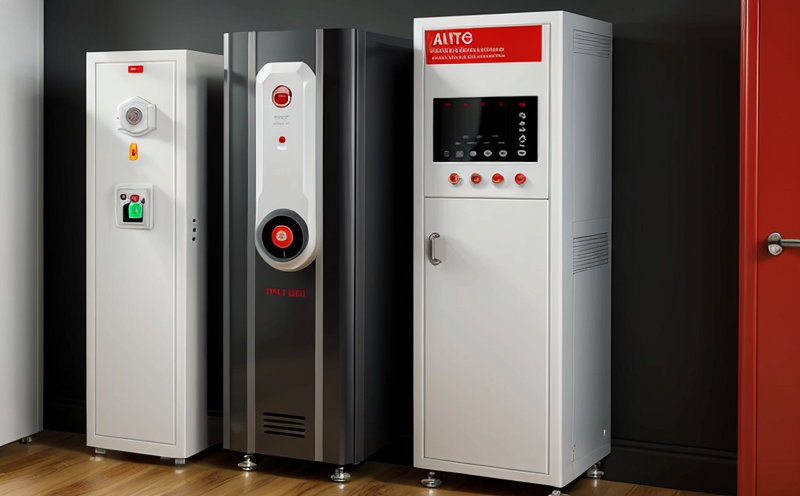EN 54-3 Fire Alarm Devices – Sounders Testing
The European Standard EN 54-3 specifies requirements for fire alarm devices, particularly sounders. This standard ensures that fire detection and alarm systems are reliable and effective in providing timely warnings to occupants. Sounders play a critical role in alerting people during emergencies by emitting loud, distinct sounds that override ambient noise.
The testing of sounders under EN 54-3 is crucial for ensuring compliance with safety regulations and performance expectations. The standard outlines detailed specifications regarding the design, construction, and operation of fire alarm sounders. Testing ensures these devices meet stringent criteria to ensure they can be relied upon in critical moments.
Sounders are categorized into several types, each designed for specific environments based on their acoustic characteristics:
- Class I: General-purpose sounders
- Class II: Sounders with a higher output level
- Class III: High-output sounders intended for large spaces or areas where ambient noise is high.
The testing process involves several steps to ensure that the sounder meets all specified criteria:
- Frequency Response: Ensuring the sounder produces a consistent frequency across its operational range, typically between 100 Hz and 4 kHz.
- Output Level: Measuring the decibel level to ensure it is within the specified range for each class of sounder.
- Signal Quality: Evaluating the clarity and distinctiveness of the signal, which must be easily recognizable by human ears.
- Harmonics: Checking that the sound does not contain excessive harmonics to avoid interference with other systems or devices.
The test setup typically includes a calibrated sound level meter positioned at various distances from the sounder, as per EN 54-3 requirements. This allows for accurate measurement of output levels and ensures compliance across different operational scenarios.
| Parameter | Description |
|---|---|
| Frequency Response | The range within which the sounder should produce a consistent frequency. Typically 100 Hz to 4 kHz for most applications. |
| Output Level | The decibel level at various distances from the sounder, ensuring it meets class-specific requirements. |
| Signal Quality | The clarity and distinctiveness of the signal as perceived by human ears. |
| Harmonics | The presence or absence of excessive harmonics that could interfere with other systems. |
In addition to these parameters, the testing also includes a durability test. This involves exposing the sounder to environmental conditions and operational stresses to ensure it remains functional over time. The duration of this test can vary depending on the specific requirements set forth in EN 54-3.
The results of the testing are documented meticulously and compared against the specified criteria outlined in the standard. Any deviations from these criteria must be addressed through adjustments or modifications until full compliance is achieved.
Industry Applications
| Application | Description |
|---|---|
| Commercial Buildings | Ensuring that sounders are effective in high-traffic areas where ambient noise levels can be high. |
| Industrial Facilities | Providing clear and distinct signals in environments with heavy machinery that can mask typical alarm sounds. |
| Parking Garages | Maintaining effective communication even when vehicles are moving around, reducing the risk of missed alarms. |
| Residential Buildings | Offering a reliable backup system in case visual signals are obstructed or ignored. |
The effectiveness of sounders is paramount in ensuring public safety. By adhering to EN 54-3, manufacturers and installers can ensure that their products meet the highest standards of performance and reliability. This is particularly important in densely populated areas where the ability to quickly evacuate a building or area could save lives.
Competitive Advantage and Market Impact
The implementation of EN 54-3 testing not only ensures compliance with international standards but also provides significant competitive advantages. By exceeding these requirements, manufacturers can demonstrate their commitment to safety and quality, thereby enhancing brand reputation and customer trust.
Compliance with EN 54-3 is a prerequisite for many fire alarm systems that are installed in public buildings or those subject to strict regulatory oversight. This ensures that the products meet not only the minimum legal requirements but also exceed expectations set by industry leaders. This can lead to increased market share and better customer satisfaction.
The testing process also helps in identifying potential areas of improvement, allowing manufacturers to innovate and develop even more effective sounders. This continuous improvement cycle is crucial for staying ahead of competitors and meeting the evolving needs of the market.
Use Cases and Application Examples
| Application Case | Description |
|---|---|
| Large Shopping Malls | Sounders are used to alert shoppers during emergencies, ensuring they evacuate safely. |
| Hospitals and Healthcare Facilities | Maintaining clear communication in areas where ambient noise can be high due to medical equipment. |
| Data Centers | Providing a reliable backup system for critical infrastructure, ensuring minimal downtime during emergencies. |
| Offices and Office Buildings | Maintaining effective communication in case of emergencies, enhancing workplace safety. |
The use cases for sounders are diverse and numerous. In large shopping malls, for example, the volume of foot traffic can be significant, requiring sounders that produce a clear and distinct signal even at a distance. Hospitals and healthcare facilities face unique challenges due to high ambient noise levels from medical equipment, necessitating sounders with excellent signal clarity.
Data centers are critical infrastructure where any interruption could have severe consequences. Sounders in these environments serve as a backup system, ensuring that all personnel are alerted quickly and effectively during emergencies. In offices and office buildings, the use of sounders helps ensure that employees can evacuate safely and efficiently in case of an emergency.





